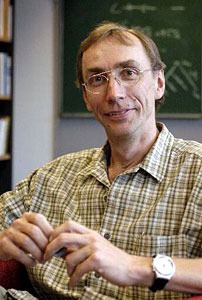
Svante Pääbo
Molecular Biologist; Director, Department of Genetics, Max Planck Institute for Evolutionary Anthropology, Leipzig, Germany
Svante Pääbo will present his work with Neanderthal DNA and the Neanderthal genome-sequencing project he is leading at the Institute, discussing our relationship to the species and the remarkable similarities and differences in our respective genomes.
Born the son of a physician and food chemist in Stockholm, Svante Pääbo became intrigued with ancient civilizations as a young boy, reading everything he could about the archaeological expeditions that unburied human history. At the age of 13, after years of pleading, his mother gave in and took him to visit Egypt. His life course, as far as he saw it, was set.
In 1975, Pääbo enrolled at Sweden’s Uppsala University to begin studies but, after two years, realized he had conjugated more ancient Egyptian verbs than he had excavated artifacts, so he changed his major and followed his father into medical school. He wound up in a doctoral program in biology, specifically molecular immunology. But Egypt was still on his mind.
With the help of his former Egyptology professors, he managed to obtain skin and bone samples from 23 mummies residing in museums in Sweden and Germany. Working nights and weekends, Pääbo succeeded in extracting and analyzing a short segment of DNA from the 2,400-year-old mummy of an infant boy. It was the first time in human history anyone had done that. He sent his report to Nature and waited for a response.
On April 18, 1985, “Molecular cloning of Ancient Egyptian mummy DNA” hit the stands—the cover story for that issue of Nature, considered by many to be the world’s leading scientific journal. It took the world of biology—and jolted the mainstream in headlines around the world. The rest is, as the saying might go, ancient history.
After earning his Ph.D. the following year, Pääbo worked at the University of Zürich in Switzerland and briefly at the Imperial Cancer Research Fund in London before going to the University of California, Berkeley. In 1990, Pääbo accepted a full professorship at the University of Munich in Germany where he continued to advance his work with ancient DNA. Within two years, he received the Gottfried Wilhelm Leibniz Prize of the Deutsche Forschungsgemeinschaft, the highest honor awarded in German research. In 1997, he accepted the post of director of the department of genetics at the Max Planck Institute, which he holds to this day.
As a biologist specializing in evolutionary genetics, Pääbo has worked extensively with modern DNA samples in his studies of genetic variation and human evolution and is a world-renowned leader of the international DNA dig into our past. He has extracted DNA from various ancient animals and plants, including mammoths, European cave bears, and maize, and led the first effort to sequence DNA from an “iceman” found in 1991 frozen in a glacier in the Tyrolean Alps where he’d been for more than five millennia. That success inspired him to look for DNA in Neanderthal bones. These ancient hominids shared the Earth with “modern” humans before dying out 30,000 years ago and are our closest relative.
Pääbo and his colleagues made history in 1997 when they reported the first successful analysis of segments of DNA from Neanderthal bones, extracted from that very first Neanderthal skeleton found in Germany’s Neander Valley near Dusseldorf in 1856. In 2002, they published their first findings on the evolution of the FOXP2 gene, the so-called “language gene” that is lacking or damaged in some individuals with language disabilities. That was only the beginning.
Pääbo decided to go after one of the toughest questions in paleoanthropology—what is the nature of our kinship with the extinct Neanderthals?
In July 2006, it was official: Pääbo’s department at the Max Planck Institute would sequence the complete Neanderthal genome, one of the most ambitious research projects in recent years. If the Neanderthal genome can be deciphered, then compared with the recently completed genome of chimpanzees, humans’ closest living relative, the “cave door” for understanding the origins of humans and why one evolutionary experiment failed and the other succeeded may be pried open.
Beyond uncovering key genetic changes that aided the transformation from the hairy, smaller-brained composition of our distant ancestors into the big-brained bipeds we are today, Pääbo has also helped show that, despite superficial distinctions, human groups from Southern Africans to Western Europeans to Native Americans are all closely related.
For his effort in developing and refining the techniques used to isolate and sequence ancient DNA, Pääbo is, by all accounts, integral in creating the field of paloegenetics or molecular paleontology and has been recognized by his peers as the “father of paleogenetics.” Last year, Time magazine named him one of the 100 most influential people in the world, and human genome scientist-entrepreneur J. Craig Venter, who wrote the accompanying article—and who presented at the 1999 Nobel Conference, “Genetics in the New Millennium”—credited Pääbo with conducting “some of the most exacting work ever attempted on the DNA of human and nonhuman primates.”